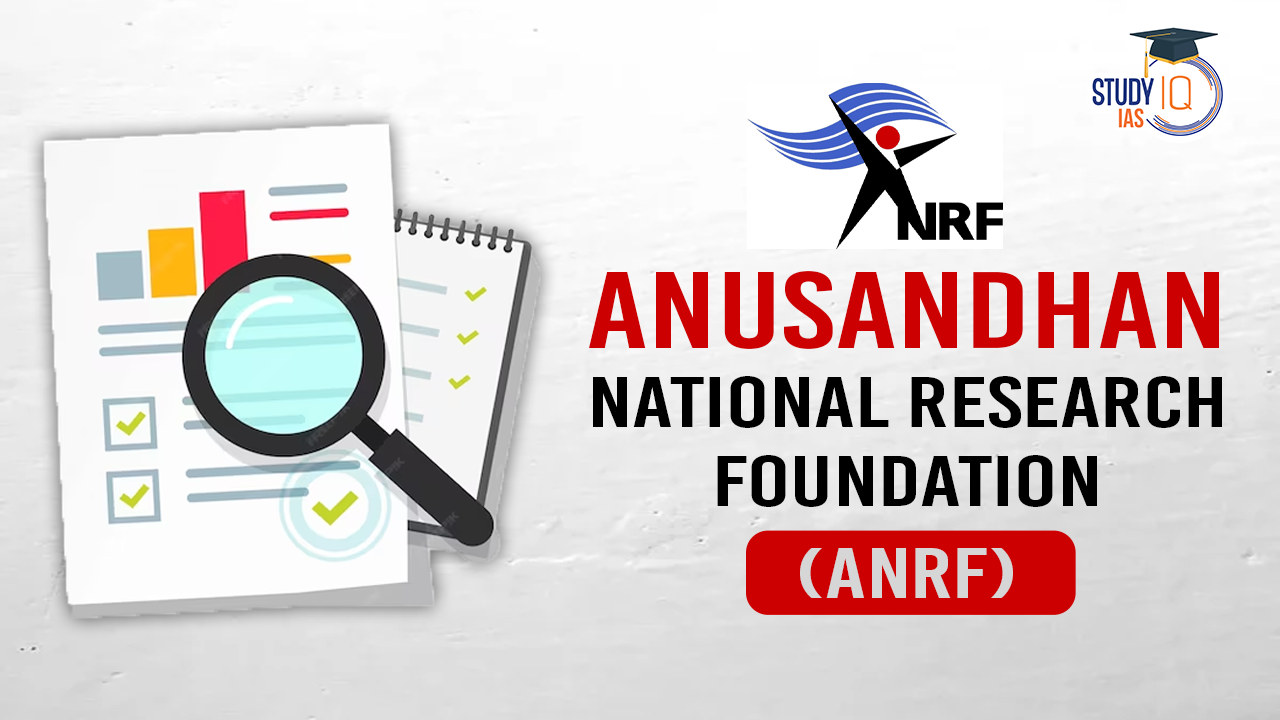Table of Contents
Context: The Anusandhan National Research Foundation (ANRF) has launched the Prime Minister Professorships to boost research in State universities by offering a ₹30 lakh annual fellowship, also allowing participation from overseas scientists and retired experts.
The Union Government recently approved a program to build partnerships between top research institutions and universities to carry out joint research projects. These research projects will be fully funded by ANRF.
Anusandhan National Research Foundation (ANRF)
- Origin: Presented in the Lok Sabha on August 4, 2023 (Statutory Body under the ANRF Act 2023).
- Repealed the Science and Engineering Research Board Act, 2008.
- Dissolved the existing Science and Engineering Research Board (SERB).
- Established the Anusandhan National Research Foundation (NRF) as the new entity.
- Aim: To increase private sector contributions to research in India.
- To ensure that a larger portion of government funds go to state universities and colleges.
- Administered by: Department of Science and Technology (DST)
Functions of NRF
- To encourage research and development (R&D) and innovation in India’s universities, colleges, research institutions, and R&D laboratories.
- Collaborating with industry, academia, and government
- Develop a regulatory framework to encourage collaboration and increase industry spending on R&D.
- Preparing a research and development roadmap for short, medium, and long-term research and development.
Budget
- ANRF is working with a budget of Rs 50,000 crore over five years.
- Government Contribution: Rs. 14000 Cr.
- Mobilisation through Private Sources: Rs. 36000 Cr.
Funding Mechanisms
Funded through:
- Government grants and loans.
- Investment income.
- Funds from the Science and Engineering Research Fund established under the 2008 Act.
Specific Funds established
- NRF Fund for administrative costs.
- Innovation Fund for creative projects.
- Science and Engineering Research Fund for ongoing projects.
- Special-purpose funds for specific projects or research.
Governance Structure
- Governed by a Board chaired by the Prime Minister of India.
- Vice Presidents include the Union Ministers of Science and Technology and Education.
- Principal Scientific Advisor acts as the Member Secretary.
- Board members include Secretaries of various scientific departments.
- Board composition can be expanded to include up to five industry representatives, one social sciences and humanities expert, and up to six specialists in natural sciences, engineering, and technology.
Organisational Structure
- Governing Board
- Chairman: Prime Minister
- Vice Chairperson: The Union Minister of Science and Technology and the Union Minister of Education are the ex-officio vice-presidents.
- Members: 15–25 distinguished researchers and professionals.
- Executive Council
- Chairman: Principal Scientific Adviser
- Members: include the secretaries of various central government departments
Executive Leadership
A Chief Executive Officer, with at least the rank of an Additional Secretary, may be appointed by the President of the Board.
Executive Council Functions
- Led by the Principal Scientific Advisor.
- Comprises secretaries from key government departments.
- Responsibilities include:
- Reviewing financial assistance applications.
- Setting regulations for financial aid applications and extensions.
- Managing the Foundation’s budget and accounts.
- Authorising inspections to verify grant application details.
| Note |
| The Executive Council can be expanded by the President to include additional government secretaries and up to three experts. |
- Accountability: The Comptroller and Auditor General (CAG) conducts annual audits of the Foundation’s accounts.
Major Initiatives by ANRF
- Prime Minister Early Career Research Grant (PMECRG): It offers early-career researchers up to ₹60 lakh over three years, with flexible funding, overheads, and international travel allowed.
- Mission for Advancement in High-Impact Areas -Electric Vehicle (MAHA- EV) Mission: It is focused on building domestic capabilities in key EV technologies such as Battery Cells, Power Electronics, Machines and Drives (PEMD) and Charging Infrastructure.
Expectations and Community Reception
The scientific community had a positive reception, expecting the ANRF to provide:
- Autonomy from bureaucratic constraints.
- Increased funding.
- Collaboration opportunities with industry.
| Facts |
|
Challenges Faced by the Anusandhan National Research Foundation (ANRF)
- Lack of Adequate Representation: The Governing Board and Executive Council lack members from the very universities and colleges they aim to support, despite over 95% of Indian students attending these institutions.
- The current makeup includes primarily high-ranking officials from various government science departments and a few academic elites, without representation from central or state universities.
- Inadequate Industry Representation: Out of significant planned funding from non-government sources (over 70%), the board includes only one industry representative, Romesh T. Wadhwani, highlighting a major gap in industry-academia collaboration.
- Underfunding: R&D funding in India is below needed levels.
- Bureaucratic and Structural Inefficiencies: The ANRF’s operational framework suffers from bureaucratic delays and lacks the flexibility needed for efficient management of funds and resources.
- The existence of multiple committees could lead to confusion and inefficiencies in decision-making.
Recommendations for Improvement
- The ANRF should ensure:
- Diverse representation includes more women, young entrepreneurs, and active scientists from the university system.
- The future CEO should have a background in both industry and academia, capable of understanding and integrating global innovation ecosystems.
- Structural changes are suggested to avoid the inefficiencies typical of other government science departments, promoting a more integrated approach between research and teaching.
- Current funding mechanisms are seen as inadequate, requiring:
- An increase in the R & D budget to 4% of GDP.
- A more efficient grant management system.
- Less bureaucratic red tape in fund disbursal and spending.
Significance
- Alignment with National Education Policy (NEP) 2020: It aligns well with the goals outlined in the National Education Policy (NEP) 2020, which emphasised the need to make India a knowledge-based economy.
- Coordination of R&D Efforts: To streamline and coordinate R&D efforts across various ministries such as defence, agriculture, and health, which currently run separate programs.
- Reliance on Non-Governmental Funding: Industry participation ensures that research aligns with market needs, while philanthropists can support research focused on social or public good areas. This helps overcome current challenges such as general financial rules (GFR) and bureaucratic delays that often hinder the timely release of funds.
- Focus on Lower Technology Readiness Levels (TRLs): At this stage, academic institutions are better suited to conduct research where capital requirements are lower, failure rates are higher, and students can contribute to long-term projects.
- This complements the government’s recent announcement of a Rs 1 lakh-crore corpus for higher TRL research in Focused Research Organisations (FROs) and deep-tech startups, covering the entire spectrum of research from basic to industry-driven development.


 Economy Beyond Headline Numbers: Why Ind...
Economy Beyond Headline Numbers: Why Ind...
 Digital Constitutionalism in India: Prot...
Digital Constitutionalism in India: Prot...
 Rethinking Urban Governance in India
Rethinking Urban Governance in India

























